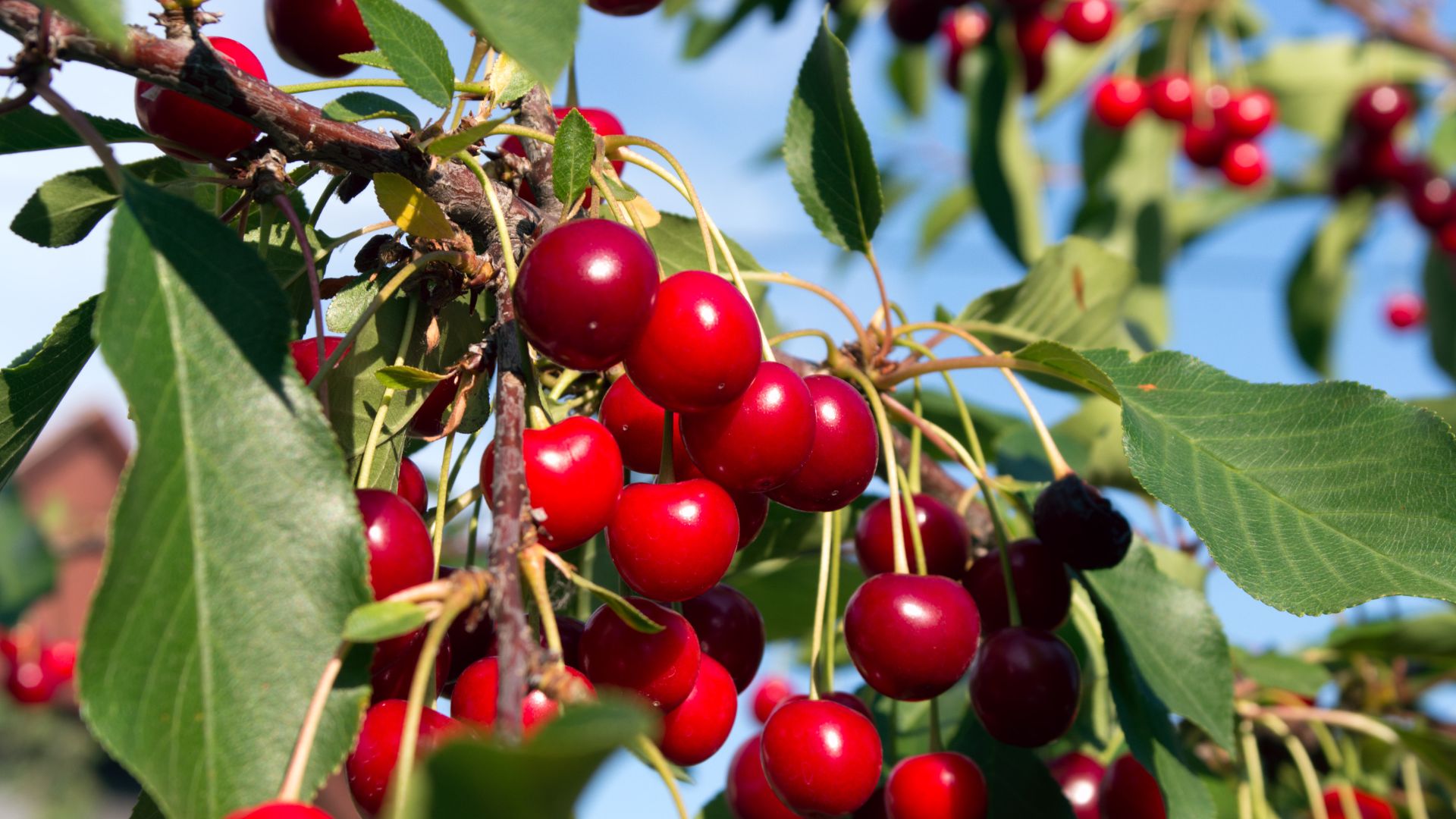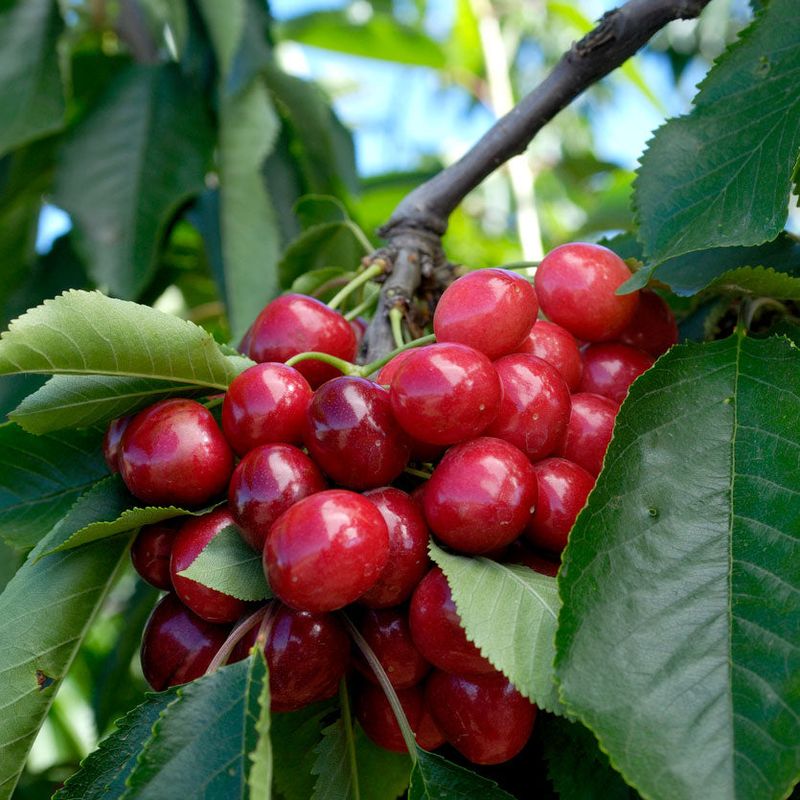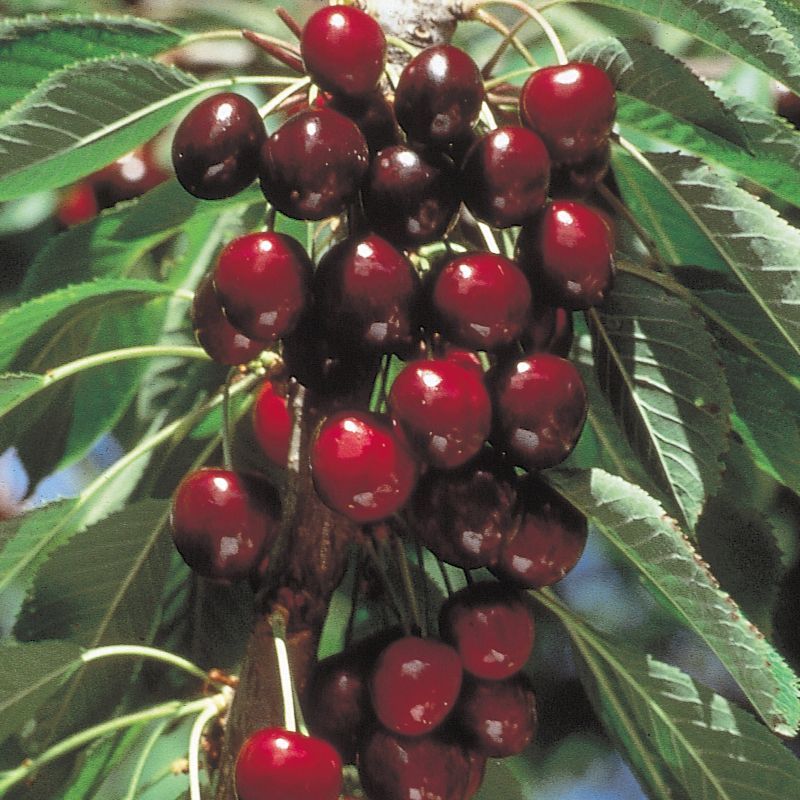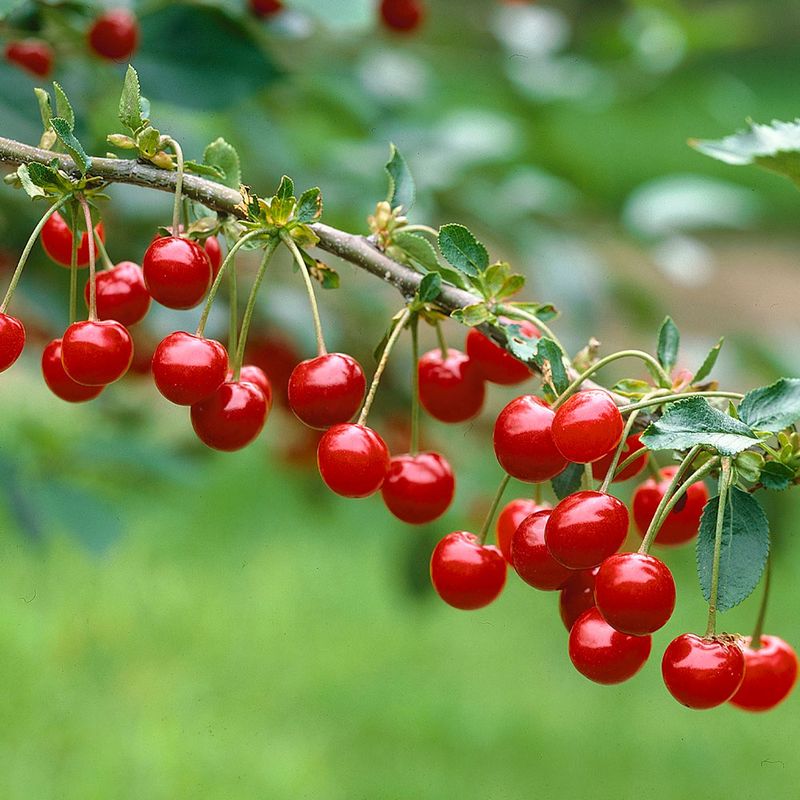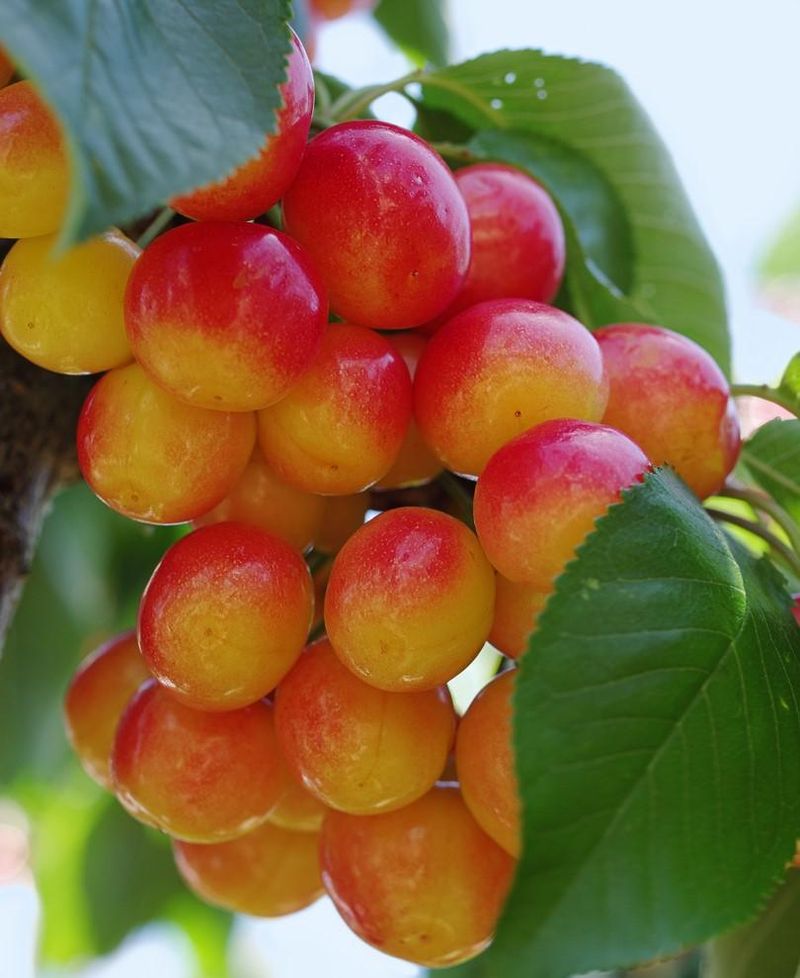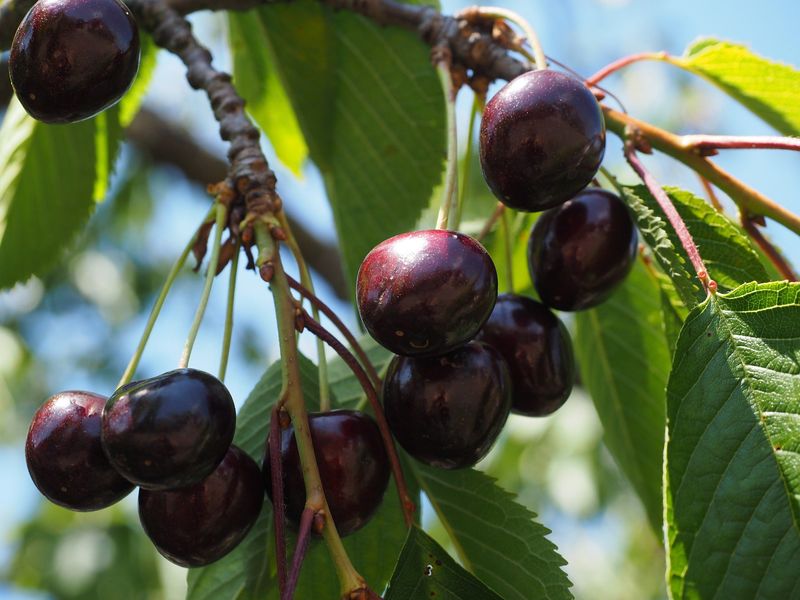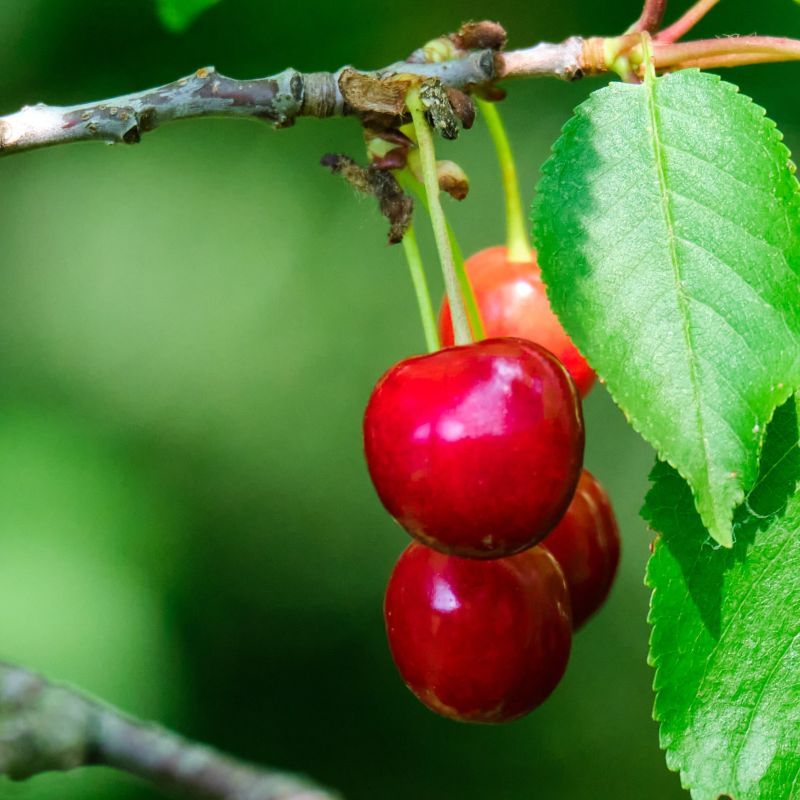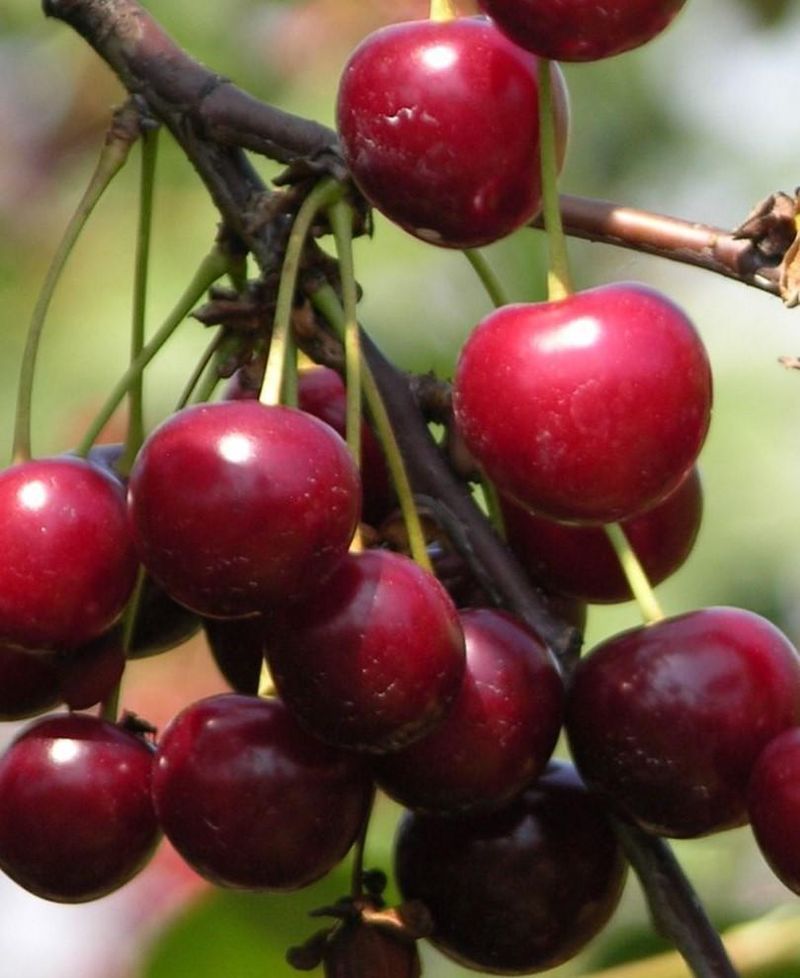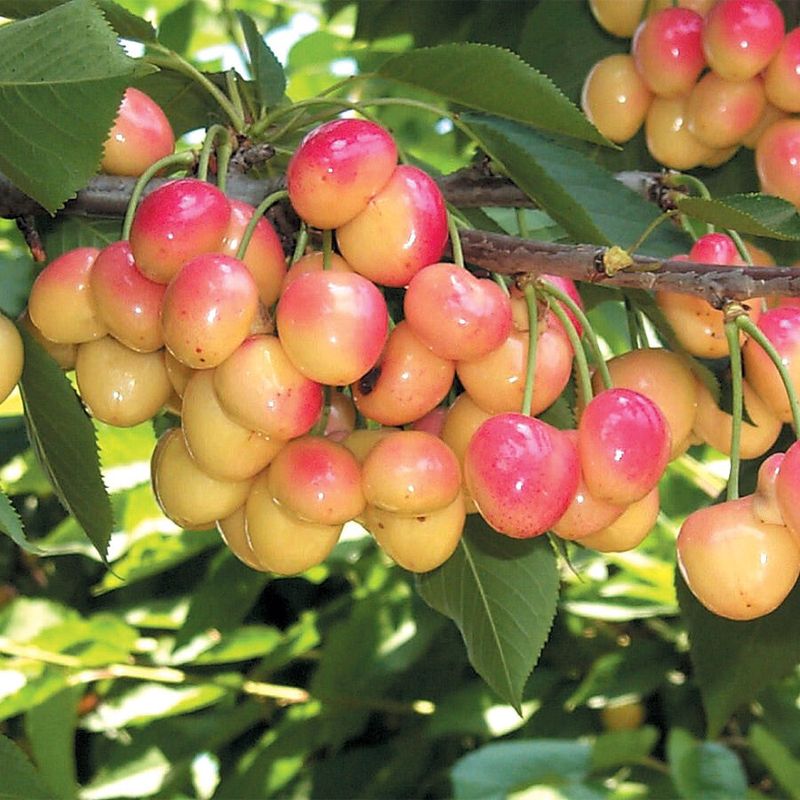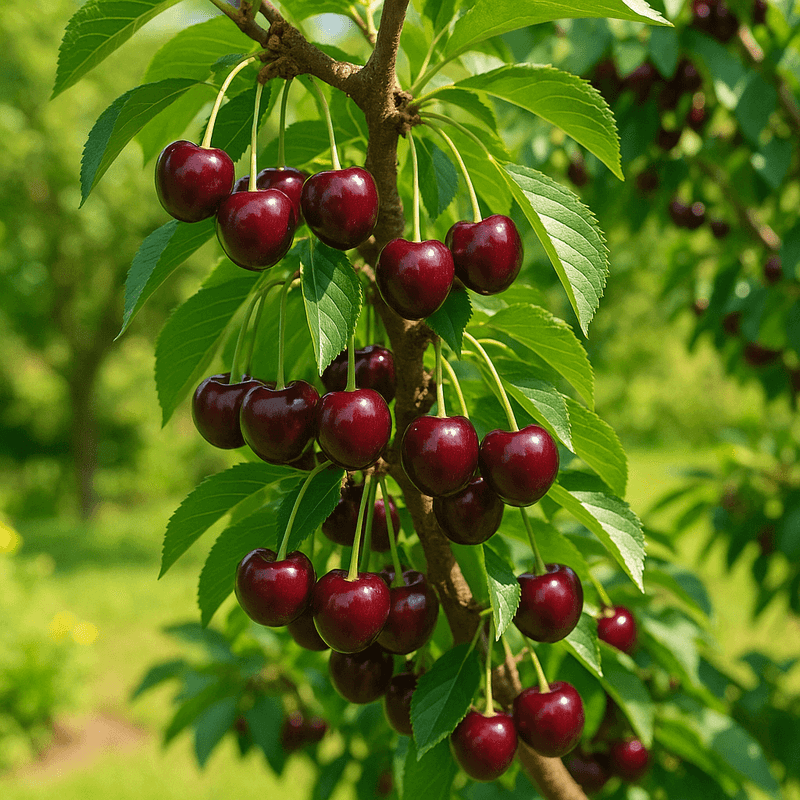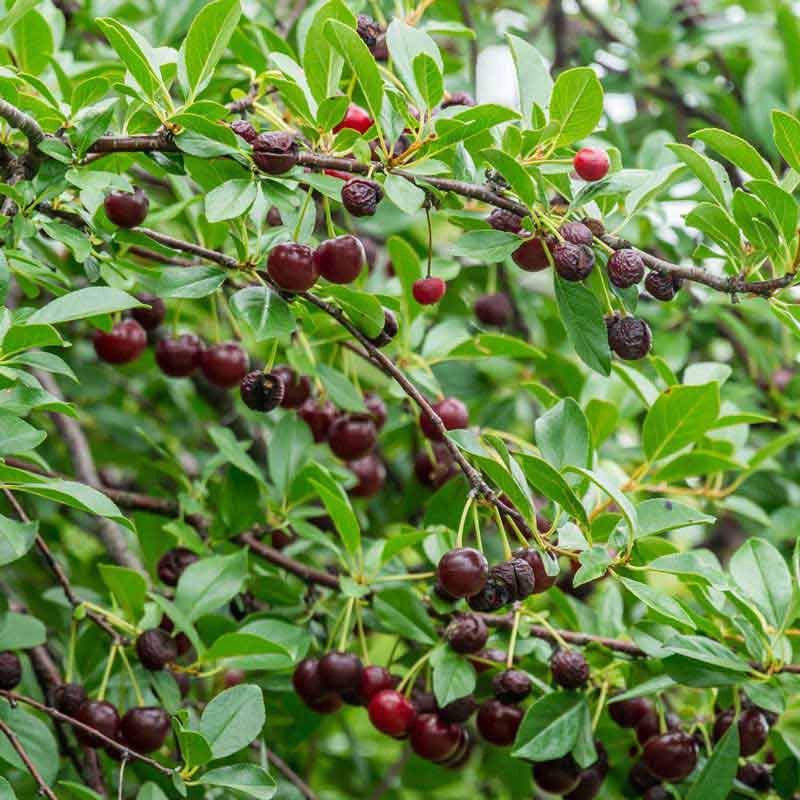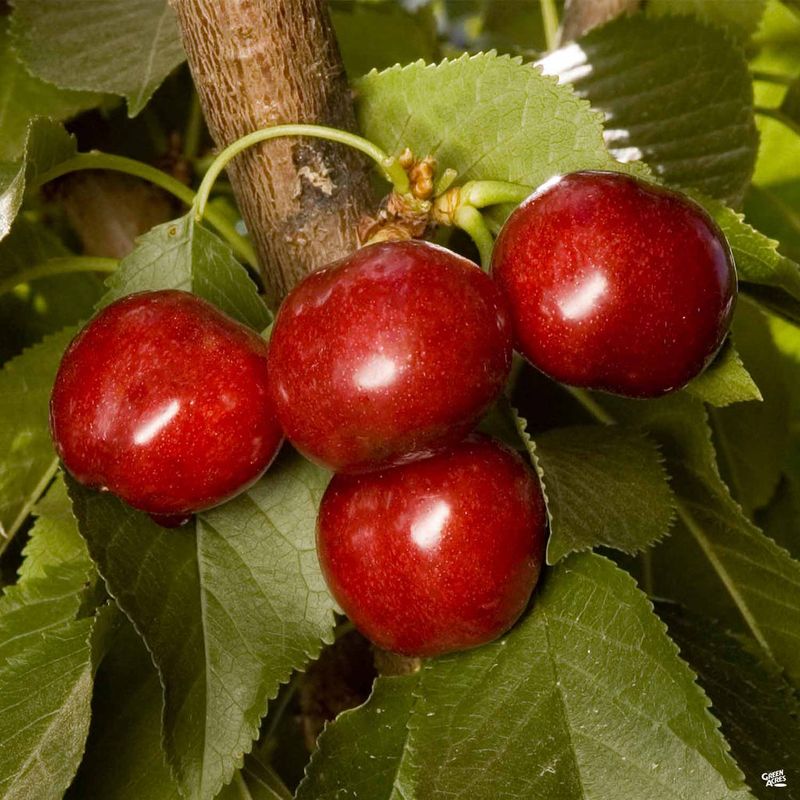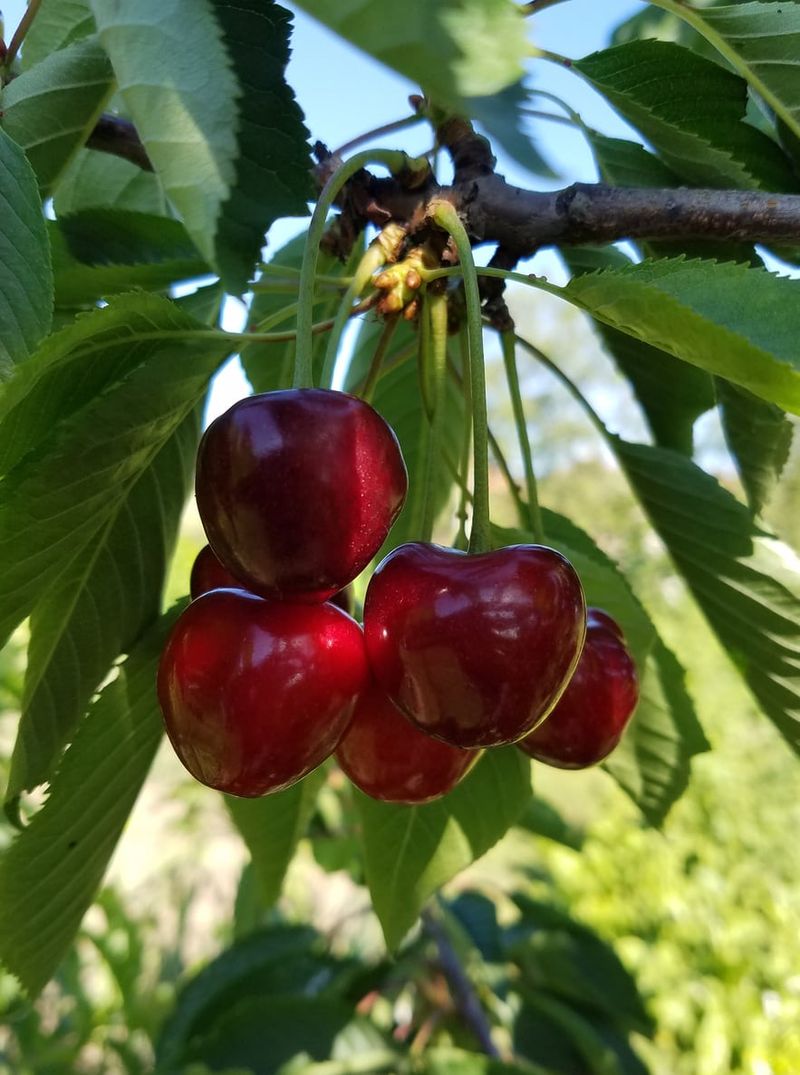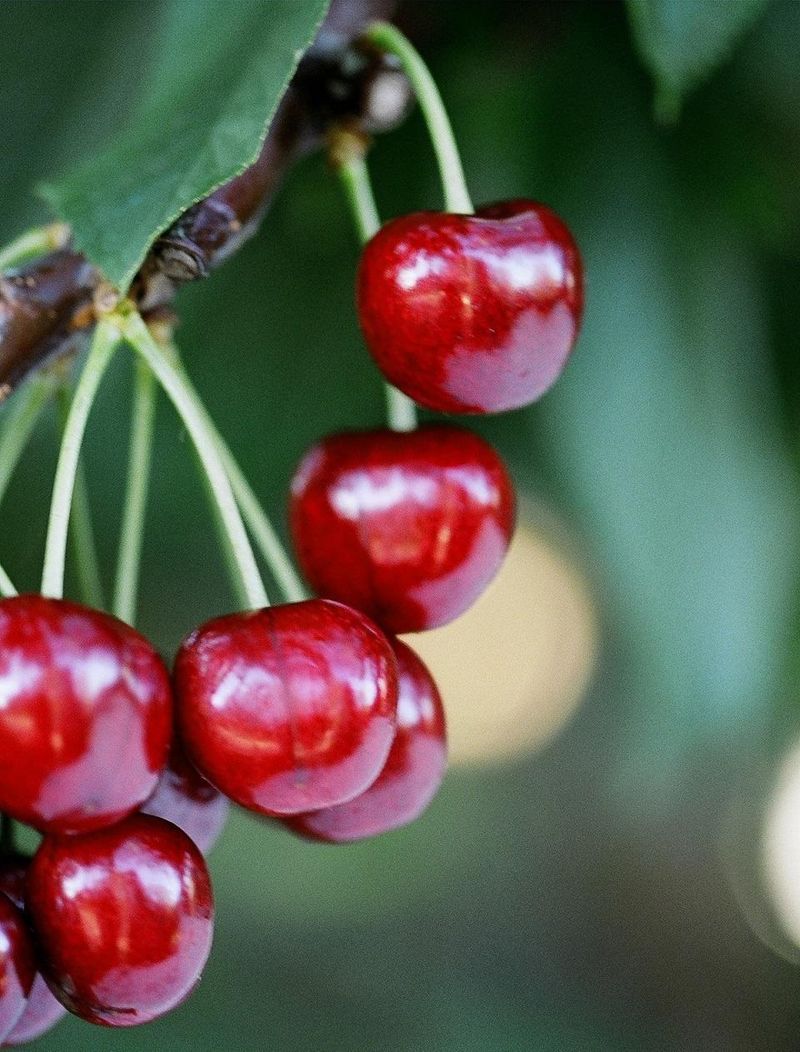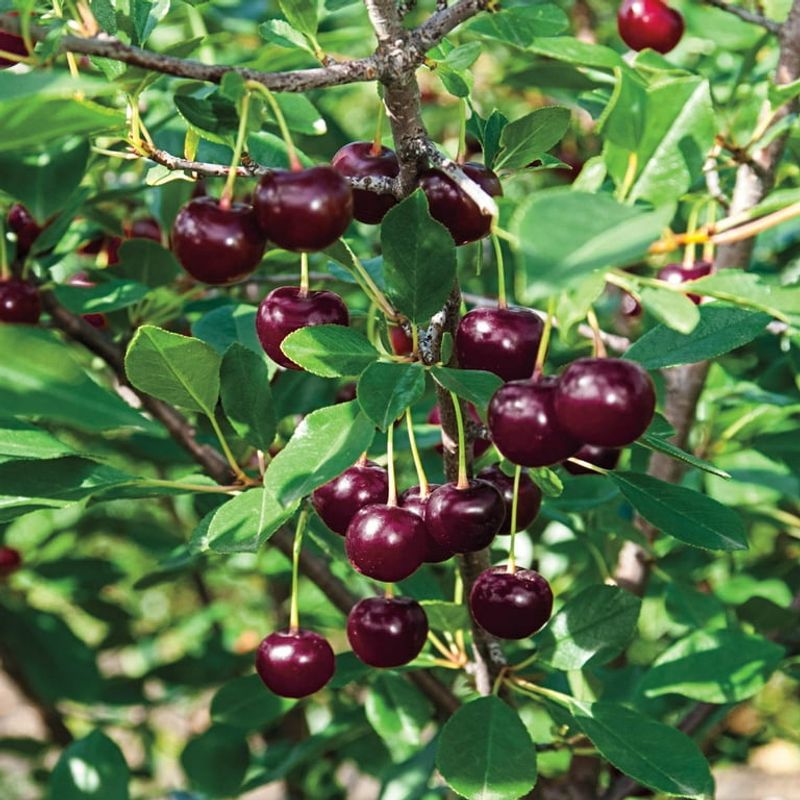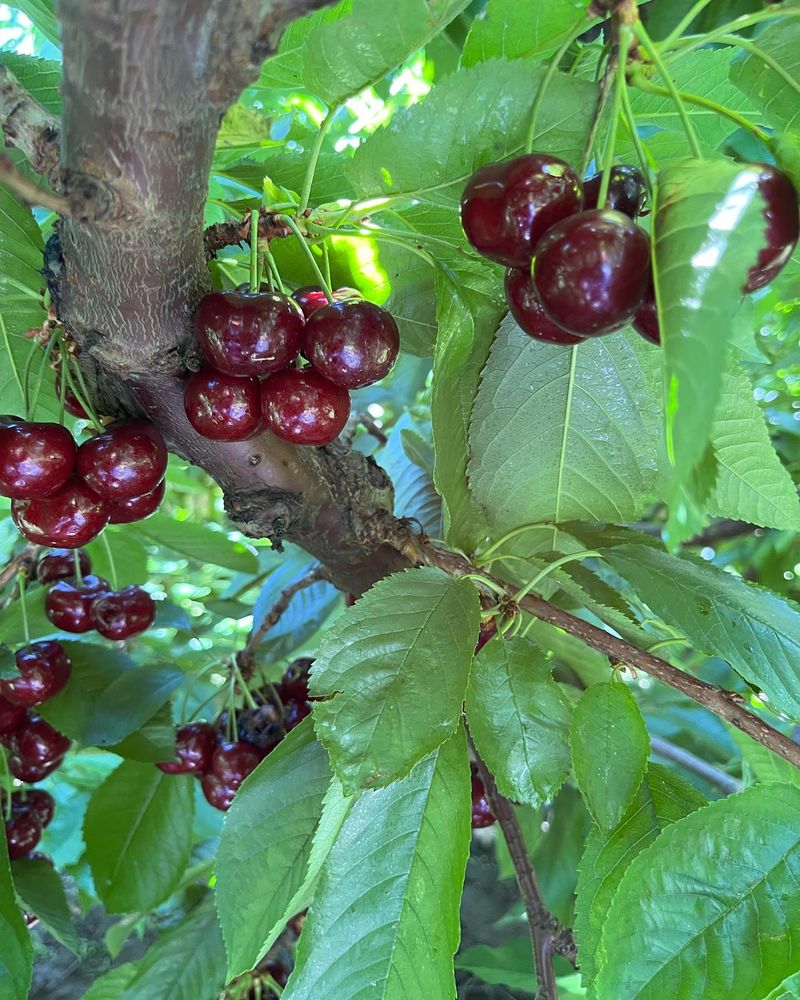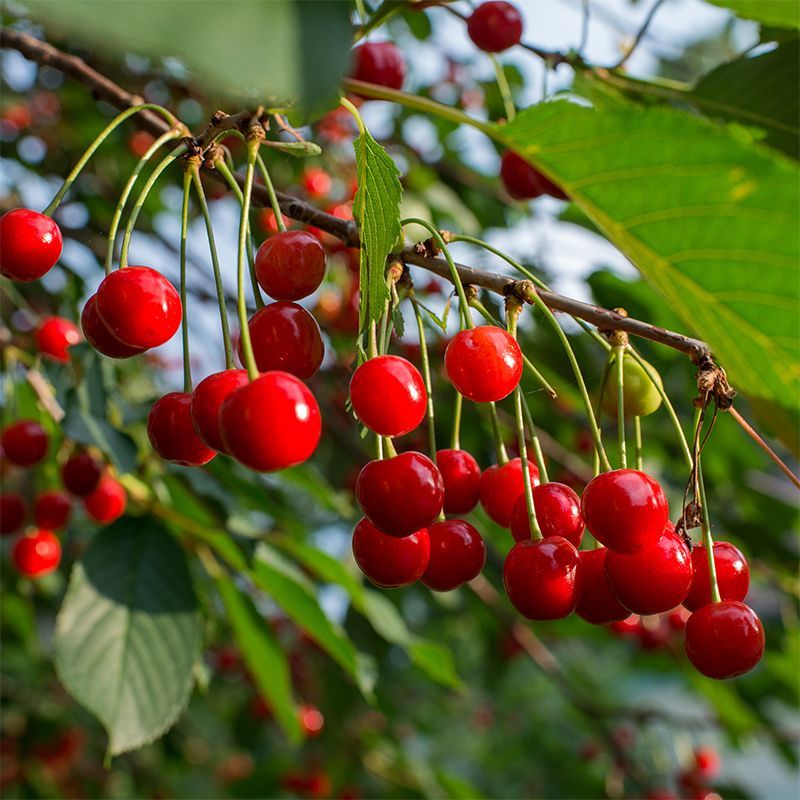Cherry trees transform ordinary yards into springtime wonderlands, with their cloud-like blossoms giving way to summer’s sweet rewards. Nothing beats plucking sun-warmed cherries straight from your own tree and enjoying that burst of flavor that store-bought fruit simply can’t match.
I didn’t realize how picky some cherry trees could be until I tried growing one from a grocery-store pit. Spoiler: it didn’t work. Some varieties need special pollination partners, while others can thrive solo in even the smallest gardens.
Whether you’re dreaming of sweet cherries for fresh eating or tart ones for the perfect pie, choosing the right variety makes all the difference between frustration and fruit-filled success. Your climate and space will narrow down your options, but these standout varieties deserve a spot on any backyard grower’s shortlist.
1. Bing Cherry
The rockstar of sweet cherries that’s been winning hearts since the 1870s. These large, mahogany-red fruits deliver that classic cherry flavor—deep, sweet, and satisfying with firm flesh that gives a satisfying snap when bitten.
Bing trees need a pollination partner like Stella or Black Tartarian to produce their magnificent crop. They prefer zones 5-8 and require about 700 chill hours to fruit properly.
For smaller spaces, look for Bing on dwarfing rootstock that keeps the tree under 12 feet tall. The fruits typically ripen in mid-June to early July, perfect timing for summer picnics and homemade ice cream.
2. Stella Cherry
Self-fertile and generous—that’s Stella in a nutshell. Unlike most sweet cherries that need cross-pollination, this Canadian-bred variety produces abundantly all on its own, making it perfect for small yards where you can only fit one tree.
The heart-shaped fruits ripen to a deep red in late June to early July. Their sweet, rich flavor works beautifully for both fresh eating and preserving.
For me, Stella’s been a no-fuss favorite—sweet fruit, minimal drama. It adapts well to zones 5-8 and stays relatively compact at 12-14 feet, though dwarf versions can be even smaller.
3. Montmorency Cherry
The pie cherry champion that’s been the backbone of American kitchens for generations. These bright red beauties pack a tart punch that mellows into something magical when baked or preserved.
Montmorency trees are tough as nails—surviving cold winters down to zone 4 and shrugging off diseases that plague other varieties. They’re self-fertile too, so you’ll get fruit even with just one tree.
My grandmother swore these were the only cherries worth canning, and after trying them myself, I understand why. They hold their shape when cooked but release that perfect balance of sweet-tart juice that makes unforgettable pies, jams, and juice.
4. Rainier Cherry
Candy-sweet with a blush of sunshine, Rainier cherries stand out with their yellow-red skin and golden flesh. Developed at Washington State University, these cherries contain less acid than dark varieties, creating an exceptionally sweet flavor that’s almost honey-like.
The trees bloom later than many varieties, helping them escape late spring frosts. They need another sweet cherry variety nearby for pollination—Bing or Black Tartarian work well as partners.
Birds find these as irresistible as humans do, so netting might be necessary. Despite this small challenge, the uniquely sweet flavor and beautiful appearance make Rainier worth the extra protection in zones 5-8.
5. Black Tartarian Cherry
An heirloom variety with Russian roots dating back to the 1700s, Black Tartarian produces fruits so dark they’re nearly black when fully ripe. The flavor is complex—intensely sweet with wine-like notes that develop fully when you let them darken completely on the tree.
These trees have a romantic, old-world charm with their spreading form and early-season white blossoms. They’re vigorous growers that can reach 20-30 feet if not pruned, creating a magnificent landscape specimen.
While they need another sweet cherry for pollination, Black Tartarian is an excellent pollinator itself for other varieties. The fruits ripen early, often before other sweet cherries, extending your harvest season in zones 5-8.
6. North Star Cherry
When space is tight but your craving for homemade cherry pie is strong, North Star comes to the rescue. This naturally dwarf sour cherry typically stays under 10 feet tall, making it perfect for small yards or even large containers.
Developed at the University of Minnesota, it’s incredibly cold-hardy down to zone 3, surviving temperatures that would kill most cherry varieties. The bright red fruits have that classic tart cherry flavor that’s perfect for baking and preserves.
Self-fertile and early to bear fruit (often by its second year), North Star has given me reliable harvests even when spring weather turned unpredictable. It’s the definition of a low-maintenance fruit tree for busy gardeners.
7. English Morello Cherry
Dark as midnight with juice like red wine, English Morello is the tart cherry for those who love bold flavors. These deep red-black fruits have colored both European and American culinary traditions for centuries with their rich, complex sourness.
The trees themselves are architectural beauties with a naturally weeping form that creates winter interest even when bare. They’re late-season producers, often not ripening until July when other cherries have finished.
Self-fertile and shade-tolerant, English Morello succeeds where other cherries fail. I’ve seen them producing respectable harvests with as little as 4-5 hours of direct sun, making them ideal for yards with partial shade in zones 4-9.
8. Royal Ann Cherry
Known as Napoleon in some regions, Royal Ann produces those classic white cherries often transformed into maraschino cherries for garnishing desserts and cocktails. Their firm, crisp flesh has a pleasant sweetness with just enough tartness to keep things interesting.
These trees put on a spectacular spring show with abundant white blossoms that attract early-season pollinators to your garden. They need another sweet cherry variety nearby for pollination—Black Tartarian makes an excellent partner.
Royal Ann has been a commercial favorite since the 1800s for good reason—the trees are productive and the large, heart-shaped fruits resist cracking even after summer rains. They perform beautifully in zones 5-8 with proper care.
9. Lapins Cherry
Another Canadian breeding triumph, Lapins delivers everything backyard growers dream of—self-fertility, crack resistance, and rich flavor. The large, mahogany-red fruits have that perfect balance of sweetness with enough complexity to keep your taste buds interested.
Developed as a cross between Stella and Van cherries, Lapins inherited the best qualities of both parents. The tree produces heavy crops without needing a pollination partner, making it ideal for urban gardens with limited space.
What sold me on Lapins was its resistance to cracking after rain—a common heartbreak with other sweet cherries. It ripens in mid to late season (usually July), extending your harvest after Bing has finished in zones 5-9.
10. Carmine Jewel Cherry
Not quite a standard cherry, this bush cherry hybrid from Canada revolutionizes what’s possible in cold climates. Standing just 6-8 feet tall, these compact plants survive bone-chilling zone 2 winters while producing tart-sweet cherries perfect for cooking and fresh eating.
The fruits are smaller than standard cherries but pack concentrated flavor that makes extraordinary jams and juices. Their natural disease resistance means you can grow them organically with minimal spraying.
After losing two standard cherry trees to our harsh winters, I planted Carmine Jewel as a last resort. Now I’m harvesting gallons of cherries from a plant that takes up no more space than a lilac bush—a true breakthrough for northern gardeners.
11. Utah Giant Cherry
When size matters, Utah Giant delivers with fruits so large they’ll make visitors do a double-take. These mammoth cherries—often an inch or more in diameter—have deep red, nearly black skin and firm, juicy flesh that resists bruising.
Developed at Utah State University, these trees thrive in areas with hot, dry summers and cold winters. They need around 800 chill hours and a pollination partner like Bing or Stella to produce their impressive crop.
Despite their massive size, the flavor doesn’t suffer—they’re richly sweet with a pleasant firmness that gives a satisfying crunch. The trees grow vigorously in zones 5-8 and start bearing relatively young compared to other sweet cherries.
12. Romeo Cherry
Another bush cherry breakthrough for cold climates, Romeo grows as a tidy shrub rather than a full-sized tree. Maxing out at 6-8 feet tall and wide, it fits into perennial borders or small yards where traditional cherry trees wouldn’t work.
The dark burgundy fruits are intermediate between sweet and sour cherries—less tart than Montmorency but with more complexity than Bing. They’re perfect for fresh eating, pies, or preserves depending on your mood.
Self-fertile and incredibly hardy to zone 2, Romeo starts producing within 2-3 years of planting. After watching these survive temperatures of -40°F without damage, I’m convinced they’re the future of cherry growing in northern regions.
13. Sweetheart Cherry
True to its name, Sweetheart wins affection with its heart-shaped fruits and extended harvest season. While most cherry varieties finish in a quick two-week window, Sweetheart ripens gradually over several weeks, letting you enjoy fresh cherries longer.
Another self-fertile variety from Canada’s breeding program, Sweetheart produces bright red cherries with excellent flavor and impressive firmness. They hang on the tree without dropping or deteriorating, extending your picking window.
I’ve found Sweetheart to be more forgiving of less-than-perfect conditions than other sweet cherries. It sets fruit reliably even in years with challenging spring weather, making it dependable for zones 5-9.
14. Juliet Cherry
Completing the romantic trio of cold-hardy bush cherries (with Romeo and Carmine Jewel), Juliet offers the perfect balance between sweet and tart flavors. The glossy, dark red fruits are slightly larger than its siblings, making harvesting a bit easier.
What makes Juliet special is its versatility—sweet enough for fresh eating but with enough acidity to shine in cooking. The fruits ripen in mid-July to early August, extending the cherry season after tree cherries have finished.
After five years growing all three bush cherry varieties, Juliet has emerged as my favorite for flavor complexity. Its compact 6-foot form fits perfectly along my driveway, where I can easily grab a handful while coming home from work in late summer.
15. Sandra Rose Cherry
A newer variety that’s quickly gaining fans, Sandra Rose produces exceptionally large, heart-shaped fruits with that elusive perfect balance of sugar and acidity. The dark red cherries have a distinctive floral quality to their flavor that makes them stand out from other varieties.
Though it needs a pollination partner like Lapins or Stella, Sandra Rose rewards the extra effort with cherries that consistently win taste tests. They ripen in mid-season, usually late June to early July in most regions.
The tree itself grows with an upright habit that makes it easier to fit into smaller yards than some sprawling varieties. It performs well in zones 5-8 and shows good resistance to cracking after summer rains—a huge plus for unpredictable climates.
16. Early Richmond Cherry
An American classic dating back to the 1800s, Early Richmond delivers exactly what its name promises—early season tart cherries when most varieties are still weeks from ripening. The bright red fruits arrive in late May to early June in most regions, jumpstarting cherry season.
These medium-sized, clear-juiced cherries have defined American pie cherry flavor for generations. They’re perfect for preserving, though a bit too tart for most people to enjoy fresh.
Self-fertile and adaptable to zones 4-8, Early Richmond trees are remarkably disease-resistant compared to sweet cherries. After losing sweet varieties to leaf spot, I planted Early Richmond as a “safe bet” and haven’t been disappointed with its reliable annual crops.

